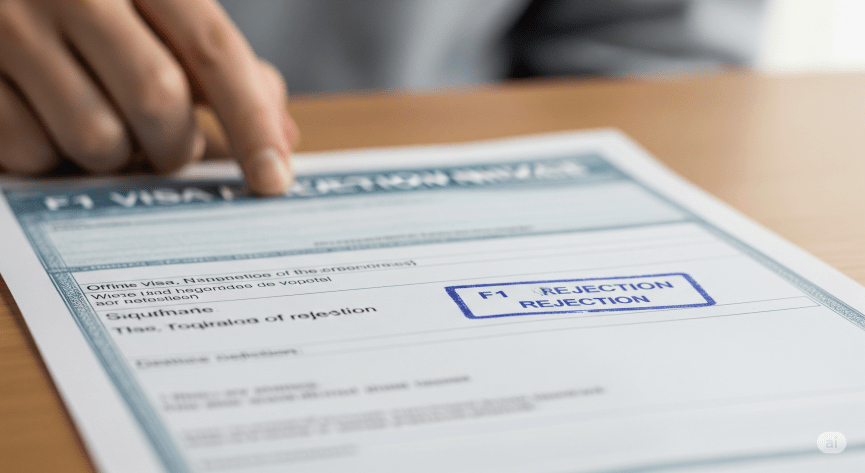Why the Thumbs Down? Let’s See Some Examples:
- Not Showing You’ll Go Back Home: This is a biggie. The US wants to make sure students come to study, not to stay permanently without the right visa.
- Example: Maybe when they asked about your plans after graduation, you didn’t mention any specific job prospects or family ties pulling you back home. Saying something like, “I’ll see what opportunities pop up,” can make them think you’re not planning to return.
- Better: “After completing my Masters in Computer Science, I plan to join my family’s business in Hyderabad, which specializes in software development.” (Remember your search history shows interest in Hyderabad – see how that fits in?)
- Money Matters Didn’t Add Up: Studying abroad costs a pretty penny, and you need to prove you have enough funds.
- Example: If your financial documents were confusing, incomplete, or didn’t clearly show you have enough to cover at least your first year of studies (tuition, living costs, etc.), that could lead to an F1 visa rejection. Saying “My uncle will help me out” without solid proof might not be enough.
- Better: Having bank statements clearly showing the required amount in your account or a sponsor’s account, along with an official sponsorship letter.
- Answers That Didn’t Quite Click: Sometimes, what you say might not fully answer the question or could even sound a bit off.
- Example: If the officer asks why you chose a specific university, and you just say, “It was easy to get into,” that doesn’t show genuine academic interest.
- Better: “I chose the University of Melbourne because of its renowned research in artificial intelligence, which aligns perfectly with my career goals in developing AI-powered solutions for the healthcare industry.” (Notice the specific reason and link to future plans).
- Coming Across Unsure or Unprepared: First impressions count! If you seemed really nervous, couldn’t answer simple questions about your program, or didn’t have your documents organized, it might have raised concerns.
- Example: Stumbling over basic questions like “What will you be studying?” or “Who is sponsoring your education?” can unfortunately lead to an F1 visa rejection.
- Better: Practicing common interview questions beforehand and having all your documents readily available.

So What Now After an F1 Visa Rejection?
Getting that “no” can be tough, but it’s not game over. Here’s your game plan:- Figure Out Why: Try to remember what the officer said. You’ll also likely get a written explanation. Usually, it boils down to them not being convinced you’ll return home after your studies.
- Talk to the Experts: Seriously, reach out to education counselors or folks who know the visa process inside and out. They’ve seen this before and can give you personalized advice. Remember you were looking at overseas education consultants in Hyderabad? Now might be a good time to connect with them.
- Look at Your Application Again: Be super critical! Did you clearly show your ties to home? Were your financial documents rock solid? Did your reasons for studying in the US make sense?
- Beef Up Your “Going Back Home” Proof: If that was the issue (and it often is with an F1 visa rejection), think about what stronger evidence you can provide. Maybe get a letter from a potential employer back home? Show property ownership?
- Practice Your Interview Skills: Get a friend or family member to do mock interviews with you. Work on staying calm, speaking clearly, and answering confidently.
- Reapply Smartly: You can try again, but make sure you’ve actually fixed the reasons for the F1 visa rejection this time. Don’t just submit the same application and hope for a different result.
- Think About Plan B: While you’re working on reapplying, it’s also smart to consider other options. Maybe look at universities in other countries like Canada or the UK. You were searching about studying there too, right?
From University Shortlisting to Visa Interview Prep, UniPlanet Has Your Back.
Book Your FREE Counselling Session Now!
FAQs
1. How can I avoid F‑1 visa rejection?
-
Complete, accurate documentation: Submit every required form and supporting document—transcripts, financial proofs, I‑20—without errors or omissions.
-
Clear study intent: Be ready to explain why you chose your particular program and how it fits your career goals.
-
Strong ties to home country: Show evidence (family, property, future job offers) that you plan to return after your studies.
-
Confident interview performance: Practice concise, honest answers. Dress professionally and maintain good eye contact.
-
Financial preparedness: Prove you can cover tuition and living expenses without resorting to unauthorized work.
-
Early preparation: Apply well before your program start date to avoid rushed mistakes.
2. What is the overall F‑1 visa rejection rate?
For the 2023–24 U.S. fiscal year (Oct 2023–Sep 2024), 41% of F‑1 visa applications were denied—a 10‑year high and up from 36% the year before.
3. After an F‑1 visa rejection, when should I reapply?
-
There’s no formal “waiting period”—you can reapply immediately.
-
But before reapplying, identify and fix the reasons for your prior denial (e.g., update documentation, strengthen financial proofs, rehearse interview responses).
-
Tip: Wait at least 1–2 weeks to gather any additional evidence and let any administrative flags clear.
4. What common factors lead to F‑1 visa rejection?
-
Incomplete or incorrect forms
-
Insufficient financial proof
-
Weak academic or program rationale
-
Unconvincing intent to return
-
Poor interview communication (hesitation, inconsistency)
-
Prior immigration or visa violations
-
Suspicion of intent to work illegally
5. What is the F‑1 visa rejection rate by country?
-
The U.S. State Department does not publish a full country‑by‑country breakdown.
-
However, in the first nine months of 2024, student visas issued to Indians dropped by ~38% (from 103,000 to 64,000), suggesting a higher refusal trend for Indian applicants compared to prior years.
